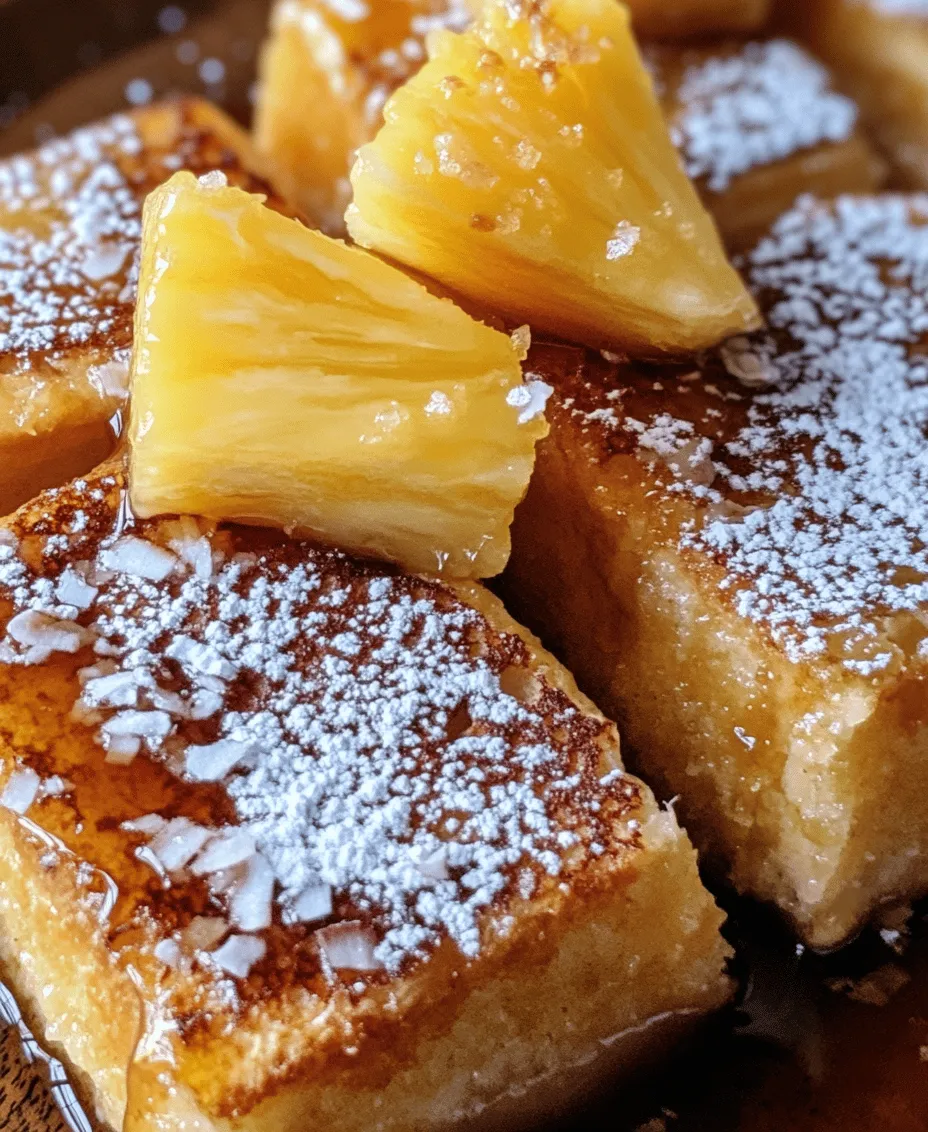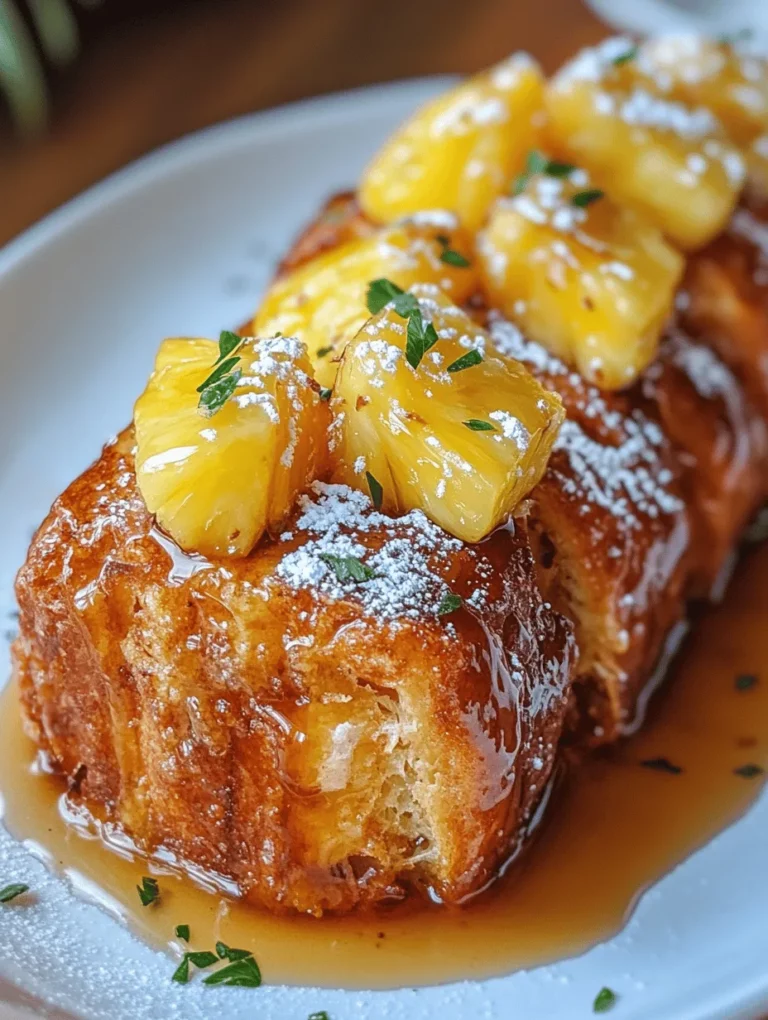Introduction
French toast has long held a cherished place on breakfast tables around the world. This beloved dish, made by soaking bread in a mixture of beaten eggs and milk before frying it to perfection, transforms simple ingredients into a delightful morning treat. The versatility of French toast allows for endless variations, making it a favorite among home cooks and food enthusiasts alike. In recent years, the use of flavored and enriched breads has taken this classic breakfast dish to new heights, and one such innovation is the Hawaiian Roll French Toast Delight.
This recipe presents a unique twist by using sweet Hawaiian rolls, known for their soft texture and subtle sweetness, to create an indulgent breakfast that evokes a tropical paradise. The combination of the rolls’ natural flavor with a rich custard-like batter results in a dish that is both comforting and exciting, perfect for family breakfasts or brunch gatherings with friends. In this article, we will provide a detailed recipe for Hawaiian Roll French Toast Delight, ensuring that each step is easy to follow while delivering delicious results.
Understanding the Ingredients
Creating the perfect Hawaiian Roll French Toast Delight starts with understanding the key ingredients that contribute to its irresistible taste and texture. Here’s a closer look at what you will need:
Hawaiian Rolls
The star of this dish is undoubtedly the Hawaiian rolls. These rolls are typically soft, fluffy, and slightly sweet, making them ideal for French toast. Their rich flavor pairs wonderfully with the custard mixture, ensuring that each bite is a delightful experience. The sweetness of the rolls comes from the addition of sugar and pineapple juice in the dough, giving this dish a unique tropical twist that sets it apart from traditional French toast.
Eggs and Milk
Eggs and milk are the essential components of any French toast recipe, forming the custard-like batter that binds the rolls together and infuses them with flavor. The eggs provide structure and richness, while the milk adds creaminess. A combination of whole milk and eggs creates a velvety texture that helps the rolls absorb the custard mixture without becoming overly soggy. For those looking to make a dairy-free version, alternatives like almond milk or oat milk can also work well.
Flavor Enhancers
To elevate the flavor of your Hawaiian Roll French Toast Delight, we incorporate several flavor enhancers, including vanilla extract, cinnamon, and nutmeg. Vanilla extract adds a warm and inviting aroma, while cinnamon and nutmeg introduce a hint of spice that complements the sweetness of the rolls. These spices not only enhance the overall flavor profile but also evoke a sense of nostalgia that many associate with homemade breakfasts.
Optional Additions
While the base recipe is delicious on its own, the Hawaiian Roll French Toast Delight can be customized with an array of toppings to further enhance its tropical charm. Fresh pineapple chunks add a burst of flavor and freshness, while shredded coconut can bring an extra layer of texture and taste. A drizzle of maple syrup ties everything together, providing a sweet finish that perfectly complements the dish. Feel free to let your creativity shine by adding your favorite toppings to make this recipe truly your own.
Step-by-Step Guide to Preparing Hawaiian Roll French Toast Delight
Now that we’ve covered the ingredients, let’s dive into the step-by-step process for preparing your Hawaiian Roll French Toast Delight. This guide will walk you through each stage, ensuring that your dish turns out perfectly every time.
Preparing the Batter
The first step in creating your Hawaiian Roll French Toast Delight is to prepare the batter. This custard mixture is vital for achieving the rich flavor and texture that makes this dish so special.
1. Gather Your Ingredients: Start by gathering the eggs, milk, vanilla extract, cinnamon, and nutmeg. For this recipe, you will typically need about 4 large eggs and 1 cup of whole milk, but feel free to adjust based on the number of servings you intend to make.
2. Whisking the Eggs and Milk: In a large mixing bowl, crack the eggs and add the milk. Using a whisk, beat the eggs and milk together until well combined. The goal here is to create a smooth mixture with no visible streaks of egg. This step is crucial for ensuring that the custard is evenly distributed throughout the rolls.
3. Incorporating the Spices: Once the eggs and milk are well blended, add the vanilla extract, cinnamon, and nutmeg. For a balanced flavor, use about 1 teaspoon of vanilla extract, 1 teaspoon of cinnamon, and a pinch of nutmeg. Whisk these ingredients together until fully incorporated. The aroma of the spices should begin to fill the air, hinting at the delicious breakfast that awaits.
4. Achieving the Perfect Consistency: The batter should be smooth and slightly thickened, resembling a custard. If you find that it is too thin, consider adding an additional egg to enhance the richness. Conversely, if it’s too thick, a splash of milk can help loosen it. The consistency is integral for proper absorption into the rolls, so take the time to get it just right.
Slicing the Rolls
Next, it’s time to prepare the Hawaiian rolls. Proper slicing is essential in maintaining the rolls’ structure while ensuring that they soak up the custard mixture effectively.
1. Choosing Your Rolls: Depending on your serving size, you may choose to use a full package of Hawaiian rolls or just a few. If you are serving a larger group, consider using multiple packages to ensure everyone gets a taste.
2. Techniques for Cutting: To slice the Hawaiian rolls, place them on a cutting board. Using a sharp knife, carefully cut through the rolls horizontally. It’s best to slice them in half or into smaller sections, depending on your preference. The goal is to create pieces that can easily soak in the batter without falling apart.
3. Maintaining Structure: While slicing, be gentle to avoid tearing the rolls. You want to keep them intact as much as possible so they can soak up the custard without losing their shape. If you prefer to keep them whole, you can also make small slits in the top of each roll to allow for better absorption.
Soaking the Rolls
With the rolls sliced and the custard prepared, it’s time for the soaking process, which is crucial in achieving the perfect texture and flavor.
1. Explanation of the Soaking Process: Soaking allows the Hawaiian rolls to absorb the custard mixture, infusing them with flavor and moisture. This step is key to creating that delightful, custardy center that contrasts beautifully with the golden, crispy exterior.
2. Recommended Soaking Time: Gently place the sliced rolls into the custard mixture, ensuring each piece is fully submerged. Allow the rolls to soak for about 5 to 10 minutes, flipping them halfway through to ensure even absorption. If you have the time, letting them soak longer can yield even more flavor, but avoid soaking for too long, as this can lead to overly soggy bread.
Once your rolls have soaked adequately, they will be ready for cooking, and the delightful transformation into Hawaiian Roll French Toast Delight will begin. Prepare for a breakfast experience that will leave your family and friends asking for seconds!

Heating the Skillet
To achieve the perfect Hawaiian Roll French Toast Delight, the first step involves heating your skillet. Begin by placing a non-stick skillet or griddle over medium heat. It’s crucial to allow the skillet to reach the correct temperature before adding your butter, as this sets the stage for a beautifully cooked French toast.
Importance of Skillet Temperature and Butter Usage
The temperature of the skillet is vital for creating a golden-brown crust that is deliciously crispy yet soft on the inside. If the skillet is too hot, the outside of the French toast may burn before the inside is cooked through. Conversely, if it’s not hot enough, the bread will absorb too much of the egg mixture, resulting in a soggy texture.
For optimal results, use unsalted butter. It allows you to control the saltiness of your dish and gives a rich flavor. Add about one tablespoon of butter to the skillet, allowing it to melt completely before adding the rolls. The butter should bubble gently but not smoke. If it smokes, your skillet is too hot—lower the heat slightly and try again.
Tips for Achieving a Golden-Brown Crust Without Burning
To ensure your French toast does not burn while achieving the desired golden-brown crust, keep an eye on the cooking time. Usually, each side should take about 3-4 minutes. You can also use a spatula to gently lift one side of the bread to check for color before flipping. If it’s not sufficiently golden, give it another minute.
Another tip is to cook in batches if your skillet is not large enough. Overcrowding can lower the skillet’s temperature and lead to uneven cooking. After each batch, add a little more butter to maintain the flavor and prevent sticking.
Cooking the French Toast
Once your skillet is prepped and the butter is melted, it’s time to cook the French toast.
Step-by-Step Cooking Instructions and Visual Cues for Doneness
1. Coat the Rolls: Take your Hawaiian rolls and dip them into the egg mixture, ensuring each side is well-coated but not oversaturated. Let the excess drip off before placing them in the skillet.
2. Cook on One Side: Place the rolls cut-side down in the skillet. You should hear a pleasant sizzle. Cook for 3-4 minutes until the underside is golden brown.
3. Check for Doneness: Use a spatula to lift one roll. If it’s golden brown, it’s time to flip. If not, allow it to cook for another minute.
4. Flip and Finish Cooking: Carefully flip the rolls over, ensuring not to break them apart. Cook for another 3-4 minutes on the other side until it’s equally golden.
5. Repeat: Continue this process until all your rolls are cooked, adding more butter to the skillet as needed.
Suggestions for Flipping the Rolls Without Damaging Them
When flipping the rolls, use a wide spatula to support the entire piece. This helps prevent any tearing or breaking. If you’re worried about damaging the rolls, you can gently slide the spatula underneath in two places, lifting it slightly before flipping. This technique ensures you maintain the integrity of your French toast.
Serving Suggestions
Now that your Hawaiian Roll French Toast Delight is beautifully golden and cooked to perfection, it’s time to serve!
Ideas for Plating the French Toast with Fresh Pineapple and Syrup
Start by placing the French toast on a warm plate. Arrange fresh pineapple slices on the side or atop the French toast for a burst of tropical flavor. Drizzle with warm maple syrup or a homemade coconut syrup for added sweetness. The contrast of the warm syrup against the fluffy French toast creates an inviting and appetizing dish.
Optional Garnishes and Their Visual Appeal and Flavor Enhancement
For an extra touch, consider garnishing with a sprinkle of powdered sugar, which adds visual appeal and sweetness without overwhelming the dish. You could also top it with whipped cream or a dollop of coconut cream for a luscious finish. Fresh mint leaves make a beautiful garnish as well, enhancing the tropical theme while providing a refreshing contrast.
Nutritional Information
Understanding the nutritional value of your Hawaiian Roll French Toast Delight can help you enjoy it even more.
Provide a Breakdown of the Nutritional Value Per Serving
A single serving of this French toast (two rolls) contains approximately:
– Calories: 380
– Total Fat: 18g
– Saturated Fat: 10g
– Cholesterol: 160mg
– Sodium: 300mg
– Total Carbohydrates: 46g
– Dietary Fiber: 1g
– Sugars: 12g
– Protein: 10g
Discuss the Benefits of Using Whole or Coconut Milk
Using whole milk or coconut milk in the egg mixture not only enhances the flavor but also adds creaminess. Coconut milk, in particular, provides healthy fats and can add a slight sweetness that complements the Hawaiian rolls beautifully. This milk alternative is also lactose-free, making it suitable for those with lactose intolerance.
Compare the Calorie Content of Traditional French Toast Versus This Recipe
Traditional French toast made with white bread and whole milk typically contains around 400-500 calories per serving. By using Hawaiian rolls and coconut milk, you may save on calories while still enjoying a rich, satisfying breakfast. The use of whole ingredients allows for a nutritious breakfast option that doesn’t sacrifice taste.
Variations and Customization
One of the best things about Hawaiian Roll French Toast Delight is its versatility, allowing for various adaptations to cater to different dietary needs or flavor preferences.
Suggest Possible Variations to the Recipe for Diverse Dietary Needs
– Gluten-Free Options: For those needing gluten-free meals, switch the Hawaiian rolls with gluten-free bread or rolls available at most grocery stores. You can also make your own gluten-free rolls using almond flour or coconut flour.
– Dairy-Free Options: Substitute whole milk with coconut milk or almond milk and use plant-based butter instead of regular butter. This modification caters to lactose-intolerant individuals and those following a vegan diet.
– Flavor Variations: You can incorporate different fruits, such as mangos or bananas, into the egg mixture for added flavor. Alternatively, spices like cinnamon or nutmeg can lend warmth and depth to your French toast. Consider adding vanilla extract for an aromatic touch.
Conclusion
Preparing and enjoying Hawaiian Roll French Toast Delight is not just about the taste; it’s also about the experience of bringing tropical flavors into your kitchen. The ease of this recipe makes it perfect for various occasions, whether it’s a weekend brunch, a holiday gathering, or a simple weekday treat.
Encouraging you to experiment with the ingredient list and customize it to your liking will only enhance your culinary journey. Each bite is a delightful reminder of the flavors of Hawaii, making this dish a memorable addition to your breakfast repertoire. So, gather your ingredients, enjoy the cooking process, and savor the tropical flavors of this delightful French toast!

